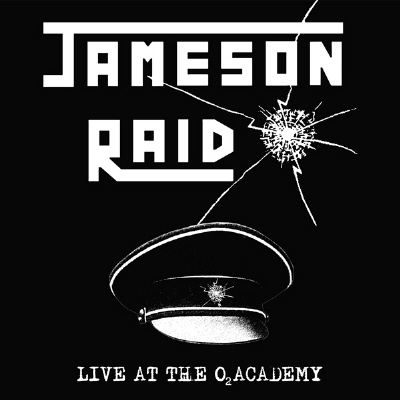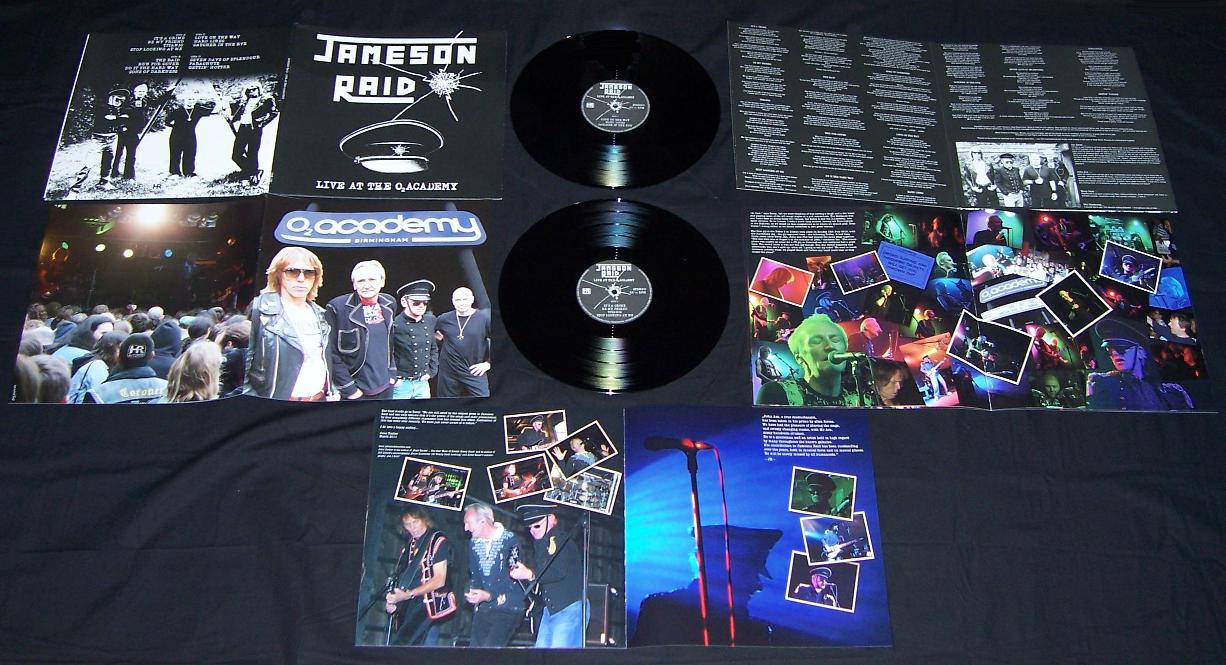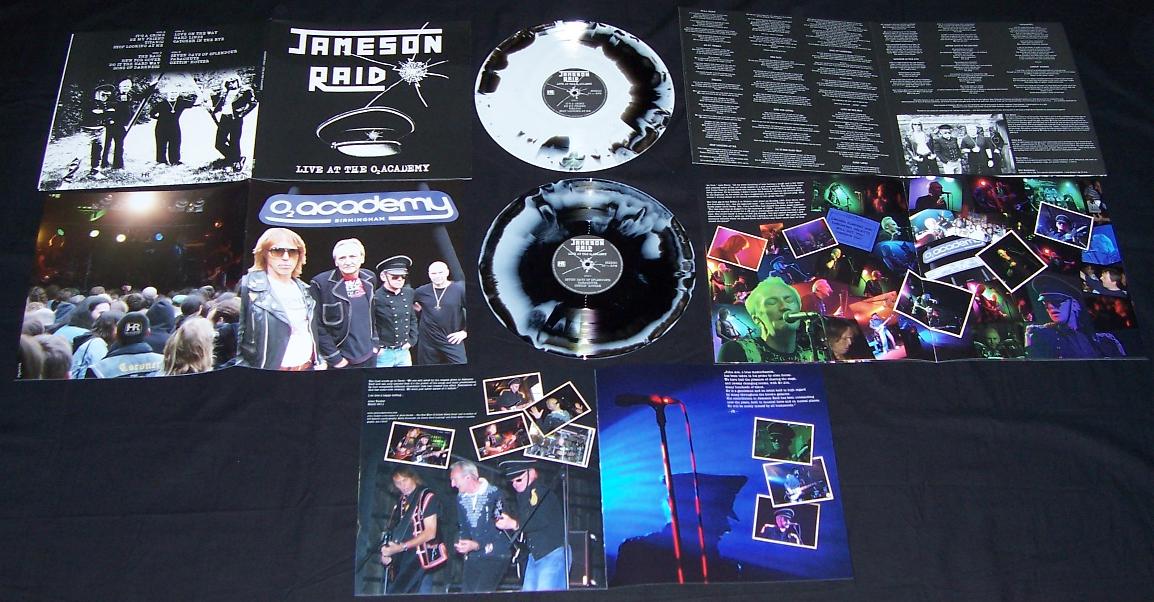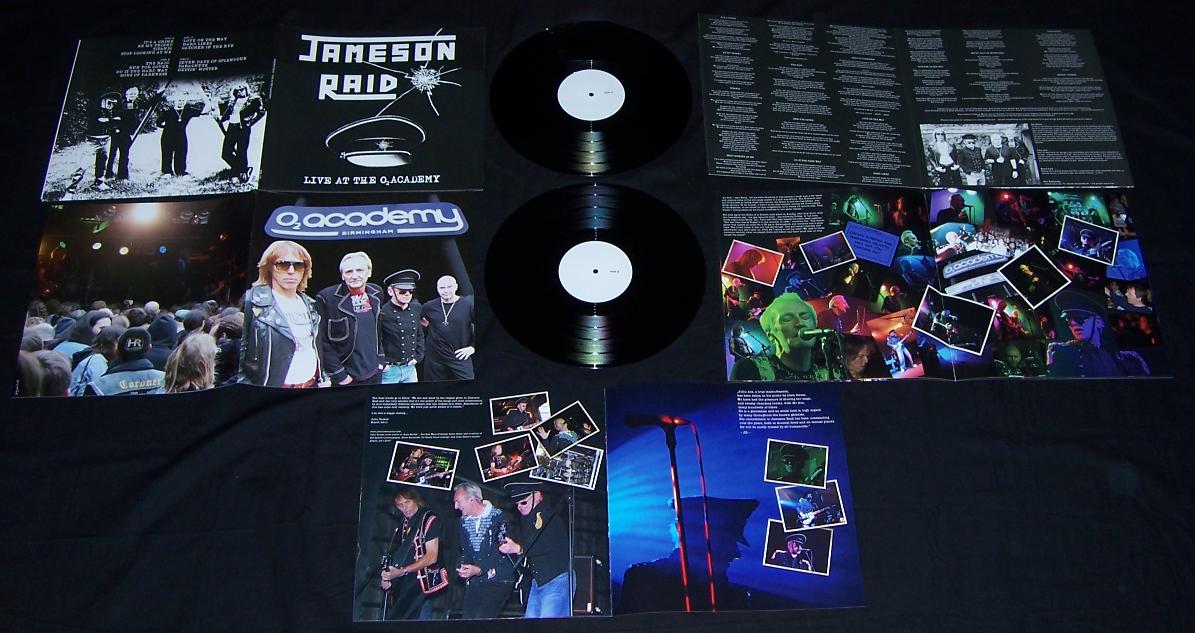 | ||||
| JAMESON RAID - Live at the O2 Academy DLP | |
HRR 180, gatefold cover, limited to 500 copies, 150 x white/ black blend vinyl + 350 x black vinyl, 12 page booklet | |
| Terry Dark - Vocals Ian Smith - Guitars John Ace - Bass Phil Kimberley - Drums | |
| -It´s A Crime -Be My Friend * -Titanic -Stop Looking At Me * -The Raid -Run For Cover -Do It The Hard Way -Sons Of Darkness * * previously unreleased | -Love On The Way * -Hard Lines -Catcher In The Rye -Seven Days Of Splendour -Parachute * -Gettin' Hotter |
| AVAILABLE | |
GETTIN’ HOTTER –
The Rise And Rise Of Jameson Raid by John Tucker
It was in 2009 that this story begins. Up until then, Jameson Raid had been pretty much consigned to the history books where they sat next to the event from which Messrs Ace, Dark, Kimberley and Smith had taken their name; the one a conflict in the Transvaal which kicked off at the end of 1895, the other a cult band from the Midlands who’d racked up just two EPs and a track on a NWOBHM compilation album before drifting into obscurity. But this is a story with a happy ending, and most stories with a happy ending need some magic; in this case the magic came in the shape of the title track of the band’s first release, the ‘Seven Days Of Splendour’ EP. The single had become a cult classic – everyone knew of it even if they didn’t actually own it – and it was highly revered amongst NWOBHM fans, not the least of whom was Neudi from German NWOBHM tribute band Roxxcalibur.
“A few years back, when my collection was quite small and contained just the ‘common’ stuff, I bought the infamous seven bootleg CDs of NWOBHM rarities,” he explains. “From these CDs I found out that I enjoyed the less well-known and rare stuff better than the more famous bands; and top of the list for me came Bleak House and Jameson Raid. I hunted down the two Jameson Raid EPs and realised that I had a new all-time favourite band. That loud and heavy Rickenbacker bass sound that’s as important as the guitars, Terry Dark’s voice with its unique quality and feeling… Their style seemed to me to be a heady mix of early heavy metal and Seventies hard rock with the accessibility of a hard-rocking club band – the best of everything, in my opinion. So, when Roxxcalibur started in 2008 ‘Seven Days Of Splendour’ was the first song we chose to rehearse. And when it came to the Keep It True Festival show in 2009 with all the guest musicians, we had two personal wishes: that Graham from Bleak House and Terry from Jameson Raid would be able to sing with us on the day. Both of them did, and if you look at the festival DVD today you can clearly see that ‘Seven Days…’ was a highlight of the show. People actually ran to the merchandise stands to buy our CD to get this great song.”
Jameson Raid’s vocalist Terry Dark takes up the tale. “In 2009 we discovered that the band was still alive in people’s memories and two dedicated websites appeared on the band without any involvement from us. At almost the same time Roxxcalibur contacted us and asked if they could cover ‘Seven Days Of Splendour’ on their upcoming album which features some of the best songs from the era. We realised that it would be a good time to have a band reunion, see each other again, catch up with our friendship and maybe play a gig together.
“This was our second reunion,” he continues. “The first took place in 1992 but without any gigs being arranged. Since Ian now lives in Thailand and I live in The Netherlands we thought it unlikely that we would be able to get together again after this one time. Then Shadow Kingdom Records contacted us with the idea of making the ‘Just As The Dust Had Settled’ album which we thought was great plan. High Roller Records also released the album in vinyl form and suddenly we were getting offers of doing real gigs at the Robin 2 in Bilston and the O2Academy in Birmingham. We were genuinely surprised but thought it would be fun so reshaped our plans so that we didn’t arrive in front of our audience as a bunch of idiots who’d forgotten how to play and sing. The Headbangers Open Air Festival in Germany also decided to take the chance to see us so our little reunion in a pub changed form quite drastically and quite quickly.”
But we’re getting a bit ahead of ourselves here. Jameson Raid’s roots go back to 1973 when bassist John Ace and guitarist Ian Smith played together in Spectaté II at school in Sutton Coldfield. The musicians went their separate ways to go to university – aside from Ian who went to sea – at which point John formed a covers outfit. When this split, he and the rhythm guitarist Stewart (whose surname has been lost to the mists of time) persuaded Ian to return to the fold and with the addition of drummer Phil Kimberley the band was ready to roll. Their first gig took place on 26th August 1975 under the generally disliked name Notre Dame. “We only used the name once, at that gig in Sutton Coldfield,” Ian confirms. “Boz [Roadie Nick Freeman"> came up with the name Jameson Raid which he’d heard in History classes in school, we liked it and that was that.” Former Hoi Polloi singer Terry Dark joined in December 1976 and Stewart the Guitarist left a few days later, and Jameson Raid’s most well-known and well-respected line-up was complete.
Aside from frustration thanks to the intervention of some studio hands at EMI (which has left an indelible mark on the musicians’ minds), the band’s memories of the period which would go onto become known as the New Wave Of British Heavy Metal are positive. “The thing about the NWOBHM,” suggests Phil, “is that back then a significant part of the magic of the music for all of us, band and fans alike, was the fact that we were all young and were utterly certain that we could do anything and achieve whatever we wanted. Rock music expressed the power and pace of all that youthful confidence. The music had a great impact then, and it still does now.” There were some obvious highlights back in the Eighties. “The gig at Sheffield City Hall backing Judas Priest is a favourite of mine,” recalls John. “Walking on stage I looked up to see faint lights – the emergency ceiling lights – in the distance against what looked like a black ‘sky’, just like a clear starlit night; then bang!, the stage lights were on and we were off! It still sends a shiver up my spine thinking about it. But of course when we first started out in the mid-Seventies the record companies were all looking for punk bands and we were judged as ‘old hat’. As time passed, well, I don’t think we even knew it was the New Wave Of British Heavy Metal… It was just the music we’d been brought up on and the most obvious music to listen to and play live. We just did it because we enjoyed it – mostly!” he laughs.
Like so many NWOBHM bands, as mentioned above Jameson Raid left little tangible evidence of their existence first time around – just 1979’s ‘Seven Days Of Splendour’ EP (c/w ‘It’s A Crime’ and ‘Catcher In The Rye’) and another EP ‘End Of Part One’ (also known as ‘The Hypnotist’) which featured ‘The Hypnotist’, ‘The Raid’, ‘Gettin’ Hotter’ and ‘Straight From The Butchers’) released the following year. And then there was the intensely-disliked compilation album track: ‘Hard Lines’ was submitted to EMI for inclusion on their NWOBHM sampler ‘Metal For Muthas Volume II – Cut Loud’, although the two-dimensional work-out was actually credited to ‘The Raid’ on the record sleeve. Some people quickly worked out that this was actually Jameson Raid – it just didn’t sound like them. Not at all.
“I can claim no personal credit for the original mix of ‘Hard Lines’,” says Phil. “I just liked playing drums and was quickly bored with the mechanics of the recording studio. As a drummer, playing live is hard work, physically and emotionally, but totally satisfying. Recording seemed to involve a little bit of drumming and then an immense period of time fiddling with little switches, dials and sliders. But for ‘Hard Lines’ Terry, Ian, John and the engineer spent hours in the studio, mixing, re-mixing and fine-tuning it until they’d produced an extraordinarily strong track. All the power of a live performance, preserved with the finest quality of the studio. Upon hearing it, however, EMI asked for the multi-track studio tape, saying they just wanted to boost the vocals a little. In fact they re-engineered it entirely and produced the thin, tinny, wretched little noise that you hear on the album today. The memory of hearing that for the first time is a memory I would be happy to lose permanently. Bizarre really, because the other tracks on that album sound good.”
As for why the band was billed as The Raid, “That was something we did, rather than another screw up by EMI,” recalls Phil. “It wasn’t intended as part of a carefully planned ‘start again’ re-branding exercise, merely an acknowledgement that fans and local media called us The Raid and, since it was a neat name either way, there was no harm – and might be some benefit – in going along with it. I'm sure it was merely experimental and, having casually started calling ourselves The Raid, I think we equally casually resumed calling ourselves Jameson Raid. I'm not even sure how long we used the shortened name, but I would guess it was no more than a few months.”
“And quite frankly, as EMI made such an awful job of the re-mix it may have been better for us as we could have denied all association with that ‘Metal For Muthas’ track,” adds John, with more than a hint of irony.
Tired of the struggle against a tide of apathy, Ian and John played their final gig with the band in Birmingham in July 1980; had they hung on, the rise of the NWOBHM would almost certainly have meant easier-to-find gigs and more acclamation. But enough was enough. Terry and Phil carried on, bringing in guitarist Mike Darby and bassist Peter Green. In 1981 the guitarist was replaced by James Barrett, who in turn gave way to Steve Makin in 1982. The four-track ‘Electric Sun’ demo cassette (‘Electric Sun’, ‘Run For Cover’, ‘Poor Little Rich Girl’ and ‘Gettin’ Hotter’) was made available, but later that year both vocalist and drummer left and the band was effectively over. Peter Green and Steve Makin tried to make a go of things under the name The Raid, with a new drummer (Roger Simms) and Steve Makin handling both guitar and vocal duties, but to no avail. A green vinyl LP ‘Jameson Raid’ did eventually come on the market; made up of the ‘End Of Part One’ EP, the ‘Electric Sun’ demo tracks, the ‘Metal For Muthas’ track and an unreleased track ‘Running Blind’ – a oddity as none of the band can remember such a song in their back catalogue! – ‘Jameson Raid’ is just a bootleg which over time has become an expensive collectors’ item.
Which brings us back to the reformation, and how it came about. “I ask myself that all the time,” laughs Phil, “although I rephrase the question to ‘what the hell happened to my quiet, respectable life?’ I think it was entirely Terry’s fault; I seem to recall it started as a mere suggestion that we have a small get-together, similar to the one we had about fifteen or so years ago when we borrowed some equipment, hired a hall and played together for just one day. After we’d all agreed that another brief reunion might be fun, Terry expanded it slowly and unobtrusively, so that none of us noticed until too late that the reunion now included several weeks of rehearsal, a couple of concerts and a NWOBHM festival in Germany, accompanied by the production of a CD of the original Raid material.” John is much more blunt: “it’s Terry’s fault,” he laughs. “But then we thought that maybe we could capture the fun we had, just once more.”
“At first,” says Terry, “all we were thinking of was having a laugh and a few beers and playing some of the old songs maybe in a pub somewhere. The Midlands was our home base so doing these two venues, the Robin 2 and the O2Academy, was fairly obvious. To be honest, I didn't know they existed, having left Birmingham in the Eighties, so we relied on fans suggestions as to where we should play. They weren’t wrong either as we found ourselves in two great venues.”
The first gig at the Robin 2 in Bilston took place on Sunday 18th July 2010, with the O2Academy gig – the gig captured here – the following Friday. It had been thirty years since Terry, Ian, John and Phil had shared the same stage together. “The last time was at Bogart’s in the summer of 1980,” confirms Ian. “The atmosphere was superb as usual for a JR gig in Birmingham and everyone had a great time. The crowd knew it was our last gig though. One guy rather bizarrely said afterwards ‘you can’t split up; what am I going to tell my kids?’ We used to break entrance records when we played there and before any band could beat us they closed the place!”
Whatever minor expectations the band might have had before the first gig were exploded as a full house turned out to see the band play live once more. Nervous? “I was excited, more than anything else,” says Ian. “I’d forgotten what a great scene it was, mixing with bands and band people. We met up with a lot of old friends and we made a lot of new friends. We could see the crowd were excited to see the band again after so long. It was a great feeling walking out on stage again after such a long break. There were so many people there – it was the best crowd the club had had in a very long time, we were told afterwards. And the old ‘we want the Raid’ chant started soon after we finished the last number. Just like the old days…”
“And,” adds Terry, “we were determined not to fall on our faces! We were nervous, of course we were, but as the crowd was so warm towards us the nerves went quite quickly. We had a few technical problems at the beginning but managed to solve them after a few songs, and on the whole we felt it went well. No gig is ever perfect; you can only aim for it. It was great to see old friends including Mike Darby and Pete Green as well, but it was the crowd that made it so special. Warm, enthusiastic, friendly… And they still knew the words after a 30 year break!”
Things were easier for the second show. “After the tremendous reception at the Robin 2 we knew the other gigs would be good,” says Ian “We’d been two weeks together by then, so everyone had loosened up and the old telepathy had returned.”
“But the crowds…” he pauses. “We thought we’d get about 50 - 100 people at each gig, but we managed around 400 - 500 at each, so that was more than just a pleasant surprise. As Terry said, there were some equipment issues at the start and during the gigs, but they were soon forgotten as we got into the show. The guitar sound on stage at the Academy was perfect – the combination of the PRS guitar and the Marshall amps was exactly what was needed for me.”
The end of the month saw Jameson Raid in Germany for the Headbangers Open Air festival. “We hired a house via the internet about an hour away and were dumbstruck when we arrived to see in old-fashioned ironwork above the door ‘1895’,” says Terry. “This apparently was the year the house was built, but was also of course the year of the Jameson Raid in South Africa. A truly mind-numbing coincidence! We had no idea what to expect from Headbangers Open Air – it was a total shock to the band. I suppose I had a small idea of what to expect [from singing at the Keep It True festival with Roxxcalibur"> but I was just as amazed by the reaction. We’d never played in Europe before so in that respect there wasn’t much pressure for us, except, again, we didn’t want people to walk away and think ‘hmm’ – we definitely wanted to entertain and make a good impression; after all, we thought, it might be our last gig ever. We were the first band on, on the Friday at 12 noon and I’d said to the guys ‘well, you know, don’t expect too much; it’s our first ever time in Europe and at this time of day…’ We were stunned to see there was a full turnout on the festival terrain, and even more so when this crowd then began to sing along with old JR favourites like ‘The Raid’, ‘Gettin’ Hotter’ and ‘Seven Days Of Splendour.’ We sold every bit of merch we had and the ‘meet ‘n’ greet’ stretched to an hour instead of the half-hour scheduled. People told us later that they’d never seen a band that went on first get such a good reception.”
2011 has already thrown up some interesting developments. The first is what Ian refers to as “a major change to the band’s line-up in the form of Paul Britton joining after John Ace was snatched by aliens.” No further explanation has been offered by the band for John’s departure, and that has been universally respected. Of the band’s new addition, Ian says, “we all know each other well, but need to get musically acquainted quickly. This should be easy as Paul has known Jameson Raid for a long, long time.” In fact, Paul had guitar lessons from Ian when he was about 16. “I was really there because I was after Paul’s sister,” reveals the guitarist now. “I didn’t manage to teach Paul much – or get off with his sister come to that! – but I did influence him to spend his life playing guitar in bands so that’s a result in itself.” The band has also been invited to play at this year’s Download festival (not bad for only their fourth reformation gig). And perhaps most magical of all, ‘Seven Days Of Splendour’ has been chosen by Rock Hard magazine as one of the best metal songs of all time. “When Roxxcalibur wanted to record ‘Seven Days Of Splendour’ I was delighted because I thought it would help prevent the song from disappearing over the horizon and, even if I say so myself, I think it deserves better than that,” says Terry. “So now, as the writer, I am extremely proud of this unexpected development, and the whole band is very honoured.” The irony is that ‘Seven Days Of Splendour’ came close to not being the band’s first release at all as, according to Ian, “there were many older songs that in a way deserved to be issued first.”
The final words go to Terry: “We are still awed by the respect given to Jameson Raid and can only assume that it’s the power of the songs and their presentation by four completely different characters that has created this effect. Realisation of this has come over recently. We were just never aware of it before.”
I do love a happy ending…
John Tucker
March 2011
www.johntuckeronline.com
John Tucker is the author of 'Suzie Smiled... The New Wave Of British Heavy Metal' and co-author of Biff Byford's autobiography 'Never Surrender (Or Nearly Good Looking)' and Brian Tatler's autobiography 'Am I Evil?'


